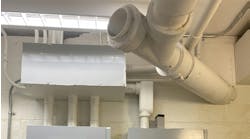You aren’t required to use the Chapter 9 tables of the National Electrical Code (NEC), but they can be surprisingly useful. Consider Table 2.
- If you are bending 1-in. EMT with a one-shot bender (manual) or a full shoe (machine), what is the minimum radius? Answer: 5.75 in.
- Your company is installing a machine it bought from a German supplier, and the raceway sizes are in millimeters. The specification calls for 16-mm and 21-mm tubing. What size EMT do you need? Answer: ½-in. and ¾-in.
- Part of that machine’s installation package came with a length of 53-mm tubing that has to be custom-bent once the machine is set in place. What size shoe do you use, and what is the minimum radius in inches? Answer: Use a shoe for 2-in. EMT; your minimum radius is 9.5 in.
Then there’s Table 4, which is actually a collection of raceway-specific tables. Each is identified by an NEC Article number and the name of a raceway type. It gives metric and SAE dimensions for combinations of wire count and fill percentage in multiple sizes of a given raceway type.
Sponsored Recommendations
Sponsored Recommendations




